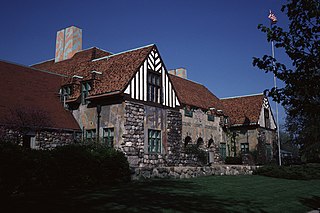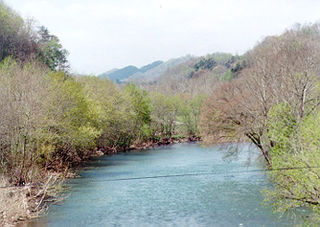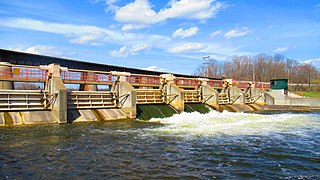Related Research Articles

A dam is a barrier that stops or restricts the flow of surface water or underground streams. Reservoirs created by dams not only suppress floods but also provide water for activities such as irrigation, human consumption, industrial use, aquaculture, and navigability. Hydropower is often used in conjunction with dams to generate electricity. A dam can also be used to collect or store water which can be evenly distributed between locations. Dams generally serve the primary purpose of retaining water, while other structures such as floodgates or levees are used to manage or prevent water flow into specific land regions.

The Illinois River is a principal tributary of the Mississippi River and is approximately 273 miles (439 km) long. Located in the U.S. state of Illinois, the river has a drainage basin of 28,756.6 square miles (74,479 km2). The Illinois River begins with the confluence of the Des Plaines and Kankakee rivers in the Chicago metropolitan area, and it generally flows to the southwest across Illinois, until it empties into the Mississippi near Grafton, Illinois. Its drainage basin extends into southeastern Wisconsin, northwestern Indiana, and a very small area of southwestern Michigan in addition to central Illinois. Along its shores are several river ports, including Peoria, Illinois. Historic recreation areas on the river include Starved Rock and the internationally important wetlands of the Emiquon Complex and Dixon Waterfowl Refuge.

Midland County is a county located in the U.S. state of Michigan. As of the 2020 census, the population was 83,494. The county seat is Midland. The county's name is due to its closeness to the geographical Lower Peninsula's geographical center. It was founded in 1831. However, it was not until 1855 that the county was effectively organized.

Billings Township is a civil township of Gladwin County in the U.S. state of Michigan. As of the 2010 census, the township population was 2,416.

Tobacco Township is a civil township of Gladwin County in the U.S. state of Michigan. The population was 2,566 at the 2010 census.

Wixom is a city in Oakland County in the U.S. state of Michigan. A northwestern suburb of Metro Detroit, Wixom is located roughly 30 miles (48.3 km) from downtown Detroit. As of the 2020 census, the city's population was 17,193.

Wanapum Dam is a run-of-the-river hydroelectric project located on the Columbia River downstream (south) from Vantage, Washington where Interstate 90 crosses the Columbia from Grant County into Kittitas County. It is owned by the Grant County Public Utility District. Its reservoir is named Lake Wanapum.

Lake Powell is an artificial reservoir on the Colorado River in Utah and Arizona, United States. It is a major vacation destination visited by approximately two million people every year. It is the second largest artificial reservoir by maximum water capacity in the United States behind Lake Mead, storing 24,322,000 acre-feet (3.0001×1010 m3) of water when full. However, Lake Mead has fallen below Lake Powell in size several times during the 21st century in terms of volume of water, depth and surface area.

The Clinch River is a river that flows southwest for more than 300 miles (480 km) through the Great Appalachian Valley in the U.S. states of Virginia and Tennessee, gathering various tributaries, including the Powell River, before joining the Tennessee River in Kingston, Tennessee.

The Wolf River is a 225 mi (362 km) long tributary of the Fox River in northeastern Wisconsin in the Great Lakes region of the United States. The river is one of the two National Scenic Rivers in Wisconsin, along with the St. Croix River. The scenic portion is 24 miles (39 km) long. The river and its parent the Fox River and associated lakes are known for their sturgeon which spawn every spring upstream on the lower river until blocked by the Shawano Dam. The river flows through mostly undeveloped forestland southerly from central Forest County in the north to Lake Poygan in the south. The lake is part of the Winnebago Pool of lakes fed by both the Fox and Wolf Rivers. The Fox-Wolf basin is usually considered to be a single unified basin and the rivers themselves may be referred to as the Fox-Wolf River system.

M-30 is a state trunkline highway in the U.S. state of Michigan that runs in a north–south direction from M-46 near Merrill to M-55 in West Branch. The highway runs through rural parts of five counties in the Lower Peninsula. The southern end runs along the Michigan Meridian and parallel to the Tittabawassee River. The southern end of the highway has been truncated twice and re-extended twice back to its pre-1962 extent.
Sanford Lake was a man-made reservoir located in Midland County, Michigan, but is no longer present since the failure of the dam in May 2020. It was formed by the damming of the Tittabawassee River near the village of Sanford, Michigan. It was built for flood control and the production of hydroelectric power. The dam is owned and operated by the Four Lakes Task Force, a property owners' group that was established by the Midland and Gladwin County boards of commissioners to oversee the dams and the impoundment lakes created by them, who took over ownership as a condition of the settlement agreement that resulted from the condemnation proceedings with former dam owner, Boyce Hydro, LLC.

A reservoir is an enlarged lake behind a dam. Such a dam may be either artificial, usually built to store fresh water, or it may be a natural formation.

M-18 is a north–south state trunkline highway in the Lower Peninsula of the US state of Michigan. It runs for 77.530 miles (124.772 km) through the central region of the state connecting US Highway 10 (US 10) near North Bradley with M-72 in rural Crawford County near the community of Luzerne. In between, the roadway connects several smaller communities while running through woodlands in both state and national forest areas. Two segments of M-18 run along sections of county boundaries, and one part of the highway forms a component of the business loop for the village of Roscommon.

The Tittabawassee River flows in a generally southeasterly direction through the Lower Peninsula of the U.S. state of Michigan. The river begins at Secord Lake in Clement Township, at the confluence of the East Branch and the Middle Branch. From there it flows through Gladwin, Midland and Saginaw counties where, as a major tributary of the Saginaw River, it flows into it at Saginaw. Its tributaries include the Chippewa, Pine, Molasses, Sugar, and Tobacco rivers.
Edenville Dam was an earthen embankment dam at the confluence of the Tittabawassee River and the Tobacco River in Mid Michigan, United States, forming Wixom Lake. The dam was about one mile (1.6 km) north of Edenville, mostly in the southeast corner of Tobacco Township in Gladwin County, with its southeastern end reaching into Edenville Township in Midland County. Its height was 54 feet (16 m), the length was 6,600 feet (2,000 m) at its crest.

The Varde is a river of Jutland, Denmark. With a length of approximately 40 kilometres (25 mi), it is the third longest watercourse in Denmark, and has a catchment area of 1,088 square kilometres (420 sq mi). The river flows through the municipalities of Varde and Esbjerg, forming the boundary between them along parts of its course.

In February 2017, heavy rainfall damaged Oroville Dam's main and emergency spillways, prompting the evacuation of more than 180,000 people living downstream along the Feather River and the relocation of a fish hatchery.

The Argo Dam is a decommissioned hydroelectric barrage dam crossing the Huron River. It is located in the city of Ann Arbor in Washtenaw County in the U.S. state of Michigan. It was built by the Detroit Edison Company in 1920 for hydroelectricity before being decommissioned in 1959 and sold to the city of Ann Arbor in 1963. The surrounding area is used for recreational purposes, including Argo Nature Area and Bandemer Park.
The state of Michigan defines an aquatic invasive species as "an aquatic species that is nonnative to the ecosystem under consideration and whose introduction causes or is likely to cause economic or environmental harm or harm to human health". There are approximately 160 invasive aquatic species residing in Michigan. Some of the most commonly known species are the Zebra Mussel, Quagga Mussel, Sea Lamprey, and several species of Asian Carp. Michigan's Natural Resources and Environmental Protection Act (NREPA) is the primary state law regulating aquatic invasive species in Michigan.
References
- 1 2 U.S. Geological Survey Geographic Names Information System: Wixom Lake
- ↑ Smith, Jerry. "Genealogy of Gladwin area place names". Gladwin County Record and Beaverton Clarion. Retrieved March 13, 2018.
- ↑ Price, Cathy Nelson (May 23, 2007). "Musselman Island: Est. 2001, pop. 2". Midland Daily News . Retrieved May 24, 2020.
- ↑ Jason (September 8, 2007). "Wixom Lake Lighthouse" . Retrieved May 20, 2020– via Flickr.
- ↑ Chris Clor (April 24, 2019). "Task Force Agrees to Buy Dams, Restore Wixom Lake in Gladwin Co". 9 and 10 News. Retrieved May 20, 2020.
Wednesday the task force announced it agreed to buy the Wixom, Sanford, Secord and Smallwood dams from Boyce for nearly $9.5 million.
- ↑ Lyden, David (April 25, 2019). "Wixom Lake Levels Expected to Return to Normal as Task Force Agrees to Buy Dams". 9 and 10 News. Retrieved May 20, 2020.
The Four Lakes Task Force agreed to buy Wixom, Sanford, Secord and Smallwood dams from Boyce Hydro for nearly $9.5 million
- ↑ "Four Lakes Task Force, as Delegated Authority for the Counties of Midland and Gladwin, Michigan" (PDF). Gladwin County, Michigan. Archived from the original (PDF) on May 20, 2020. Retrieved May 20, 2020.
the Four Lakes Task Force, in its capacity as the County Delegated Authority for the Four Lakes Special Assessment District
- ↑ Erin Ailworth; John D. Stoll (May 20, 2020). "Failed Michigan Dam Lost License in 2018". The Wall Street Journal . Retrieved May 21, 2020.
After its license was revoked by FERC, regulation of the Edenville dam was taken over by the Michigan Department of Environment, Great Lakes and Energy in 2018. Spokesman Nick Assendelft said the agency inspected the dam in October 2018 and found it structurally sound
- ↑ "Wixom Lake". ww5.findlakes.com. Retrieved May 20, 2020.[ permanent dead link ]
- ↑ "Frequently Asked Questions". Four Lakes Task Force. Retrieved May 20, 2020.
- 1 2 Flesher, John (May 20, 2020). "Michigan dam had repeated safety violations before flooding". Washington Post . Associated Press.
The company twice lowered Wixom Lake's level without permission after the federal license was revoked, said Nick Assendelft, spokesman for the Michigan Department of Environment, Great Lakes and Energy, which has overseen the Edenville barrier since its federal license was withdrawn [...] A lawsuit filed April 30 says the lengthy drawdowns in 2018 and 2019 killed "thousands, if not millions" of freshwater mussels, many listed as endangered species
- ↑ Riley Beggin; Mike Wilkinson; Kelly House, Bridge Magazine (May 20, 2020). "Feds revoked dam's license over safety issues. Then Michigan deemed it safe". Archived from the original on January 18, 2021. Retrieved May 21, 2020.
State officials alleged Boyce's dams lowered the lake without permission in 2018 and 2019, and sued the company in April alleging the actions killed "thousands if not millions" of endangered freshwater mussels.
- ↑ Garret Ellison (21 May 2020). "Failed dam owner fought with state over Wixom Lake levels before flood". Booth Newspapers . MLive . Retrieved 21 May 2020.
Boyce says it asked EGLE for permission to lower Wixom Lake last fall "due to concern for the safety of its operators and the downstream community." EGLE and the Michigan Department of Natural Resources denied the request. Boyce lowered the lake without approval in mid-November "believing its safety concerns were paramount." Boyce sued the state on April 29 in Grand Rapids federal court
- ↑ Riley Beggin; Mike Wilkinson; Kelly House, Bridge Magazine (20 May 2020). "Feds revoked dam's license over safety issues. Then Michigan deemed it safe". Archived from the original on 18 January 2021. Retrieved 21 May 2020.
State officials alleged Boyce's dams lowered the lake without permission in 2018 and 2019, and sued the company in April alleging the actions killed "thousands if not millions" of endangered freshwater mussels.
- ↑ Acosta, Roberto (May 19, 2020). "Residents told to evacuate after Edenville Dam failure in Gladwin County". MLive . Retrieved 19 May 2020.
43°49′25″N84°21′44″W / 43.82361°N 84.36222°W